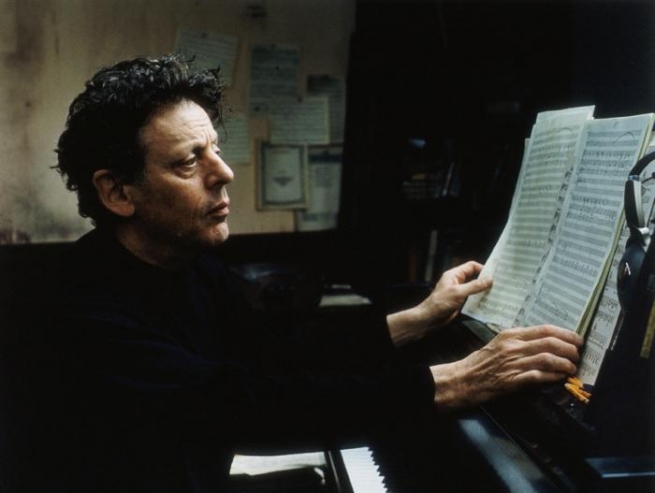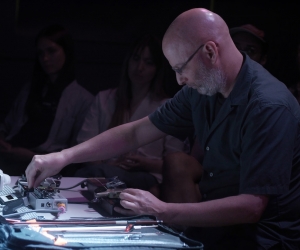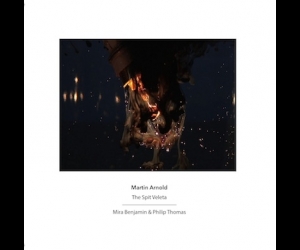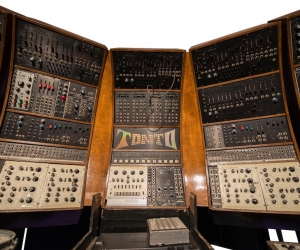
Most people get presents or have parties thrown for them on special occasions. Philip Glass, however, was in more of a giving mood as he celebrated his seventy-fifth birthday at the end of January. The candles on his cake marked the start of a remarkable year that has the American composer travelling around the world to—among other things—present solo-piano recitals, chamber-music concerts, and to participate in the remounted Einstein on the Beach, the new-music opera that earned him worldwide respect and fame in the mid-1970s. The fifth scheduled stop for Einstein in 2012 is Toronto, where the June 8–10 performances at the Luminato Festival mark the show’s Canadian première. Billed as the official North American première for this remount, the occasion is an ideal excuse to look for some insights on what has made Glass and minimalism such a potent and popular mix in the world of new music.
Nearly thirty-six years have passed since the sprawling, five-hour, four-act Einstein on the Beach had its world première at the Avignon Festival in France, but the piece, usually billed as an opera, continues to be a source of wonder for both returning audiences and newcomers alike. Luminato is one of a cluster of presenters in North America and Europe that share co-commissioner billing for this remount. The effort was pulled together by Linda Brumbach of New York City-based Pomegranate Arts, an independent producer that has prepared a broad menu of programming around Glass’s seventy-fifth birthday year. The production coming to Toronto is a faithful reproduction of the original, which Glass conceived jointly with artist Robert Wilson. Glass himself will be in the orchestra pit, as he was at Einstein’s première.
Luminato CEO Janice Price describes how she and then-artistic director Chris Lorway were introduced to Wilson’s business manager Jörn Weisbrodt—now artistic director of Luminato—following the inaugural Luminato festival in 2007. At the time, Weisbrodt ventured that there was some interest in mounting a revival production sometime soon. “I’m such a fan of this opera,” declares Price. “Like so many people—anyone under age fifty—I have only been able to listen and fall in love with the music [on recording]. I didn’t know if I would ever have a chance to see it performed live, and certainly not with the original creators still involved.” According to Price, Brumbach had all the co-commissioning companies lined up by the summer of 2010, with Luminato getting the first North American dates following a short run of preview shows in Ann Arbor, Michigan in January. The official world première for this incarnation of Einstein on the Beach is scheduled for March 16 in Montpellier, France. The journey to Toronto continues via Italy and London, England, and will conclude with presentations in Amsterdam before Glass’s seventy-sixth birthday, next January.
An American opera in Paris
Looking more like the neighbourhood handyman than a modern musical icon, Glass insists, during an in-person interview last spring, that he has considered himself a composer for the theatre since age twenty. “When I was a student at Juilliard, I asked myself a very simple question: Who wants my music?” says Glass with a smile. “I began by going to the dance department, and listened to people there. Before long, I was writing music for the dance classes.” Other work followed quickly. “Within that first year, I did music for a production of [Molière’s] Les Fourberies de Scapin. I wouldn’t get paid for these things. Sometimes, I would get twenty-five dollars, which would barely pay for the recording. But that was part of my training,” Glass recalls. “Those skills I acquired very, very early, so when I had the [Philip Glass] Ensemble, I found that I was at home in that world. What I was looking for was a way that a composer could function in the world. That was real. People were interested; they really wanted the music.”
In an in-person conversation, the composer makes the birth of Einstein on the Beach sound like the most natural thing. Other accounts have differed a bit, suggesting that Glass and artist Robert Wilson worked through several possible subjects before settling on the main themes from the life of the famous scientist. By the time that Glass and Wilson met in 1974, the seven-member instrumental consort later known as the Philip Glass Ensemble had been performing together for seven years. “We knew how to work together so well that, to be truthful, we never even talked about it,” says Glass from the distance of nearly four decades. According to Irish-born sound artist David Cunningham’s essay on Einstein, Wilson supplied visual mock-ups for each scene, Glass would write the music, and then the duo would exchange modifications until they felt they had achieved balance. “I hadn’t actually written an opera, but I’d written everything but an opera,” Glass recalls, before pointing out that neither he nor Wilson ever explicitly imagined Einstein as an opera.
Borrowing a page from the existentialists’ philosophical playbook, Glass says the work came to be called an opera because it needed to be produced in a hall with a proscenium stage and an orchestra pit, as well as ample flies and wings, plus singers and dancers. “So, we did Einstein on the Beach, and people would ask, why are you calling that an opera? We would answer that we never called it an opera. But, of course, that’s a very provocative thing to say,” Glass remembers. “We had these ludicrous conversations with audiences, and, finally, I said, ‘Look I call an opera things that you see in an opera house. What’s a stable? A stable is where horses live.’”
The Avignon première led to a three-month European tour with the Ensemble and twelve singers who doubled as corps de ballet. “We couldn’t afford anything more,” says Glass. During a run at the Opéra-Comique in Paris in the early fall of 1975, a producer and lighting designer from the Metropolitan Opera in New York City came to see the show. “They came and talked to us and said, we’re going to be bringing the opera to the Met.” Glass explains how the company was, at the time, looking for new works with which to fill traditionally dark nights at the theatre. “We just started giggling. It was very improbable,” Glass continues. “Working in Europe was one thing. Working in America was impossible, with the exception of New York, so we just forgot about it.” But the Met didn’t. When Glass and Wilson landed in New York after Einstein’s European premières, they were met by a friend at the airport, who congratulated them on being sold out. “We said, ‘What’s sold out?’” Glass exclaims, chuckling.
Poetry in process
“Poetry thrives on the constant tugging between repetition and variation,” writes American poet and teacher John Drury in his book, Creating Poetry. “Meter represents a monotonous, hypnotic regularity; metrical substitutions (placing stresses, for example, in a spot that’s normally weak and unstressed), rouse us by the surprise of variety; they represent the constant and the variable, the norm and the departure, the backbeat and the syncopation, the familiar and the unexpected. Poems may highlight one or the other, but both are necessary.”
Substitute the words “music of Philip Glass” for “poetry” in that passage by Drury, and it could be describing Einstein, Satyagraha (the 1979 opera on the life of Mahatma Gandhi), the film score for The Hours, or even Glass’s 1987 Violin Concerto.
Einstein is an excellent point of entry into Glass’s creative ethos, because it comes from a period in the American composer’s life when the pieces of his musical signature were coming together within a narrative context, rather than merely being expressions of a process. Up until the development of Einstein, the melodic fragments and their repetition are the products of a purely mathematical process of addition and subtraction, and Glass and Robert Wilson presented Einstein on stage with a similar mathematical rigour, giving it a shape as clearly defined as the facets of a finely cut diamond. But no amount of analysis of 1+2 or 1+3 (or the several other permutations of 1, 2 and 3) in Einstein on the Beach can begin to address what transports a mathematical and geometric exercise into the realm of art. For all its abstraction in trying to depict Albert Einstein’s Theory of Relativity with visual symbolism and without traditional dialogue, this opera does have an emotional core. “Generally the visual element and the music mesh to provide the emotive experience,” wrote David Cunningham in his 1977 essay, “Einstein on the Beach,” published in editor Richard Kostelanetz’s book, Writings on Glass: Essays, Interviews, Criticism.
“One of the interesting things for me about [Einstein] is that there is an emotional content to the music that seems to come spontaneously from the music itself,” Glass told Cunningham. He suggested at the same time that this element of mood or emotion is unintentional: “In making the pieces and writing the pieces, I’m almost always thinking of practical items such as rhythmic structure, harmonic structure, and melodic structure; I’m thinking of the length of time of the piece and how it fits into the action on the stage and the décor that it’s going with.” But Glass does understand the alchemy taking place on stage: “What happens is that perhaps because of the way I work, or because of my own nature, or perhaps because of the results of all these processes, there comes into the music, I would almost say spontaneously, an emotional content of its own. I think it’s because the music attains a reality of its own or say an individuation of its own, and once it achieves that it appears to have its own emotional dimensions.”
Over the past four decades, Glass has repeatedly denied any interest, affinity or link with the mystical side of the art of composition. But the Baltimore-born composer’s longstanding Indian connection could suggest otherwise. Glass went to India in the mid-1960s, formed an attachment to Tibet, and had a creative epiphany while working with sitar master Ravi Shankar in the early 1970s. After the two met, Shankar—who sought out high-profile collaborations in the pop as well as art-music worlds—asked Glass to transcribe some traditional Indian music into Western notation, so that it could be more easily shared with people not familiar with Indian traditions. In the process, Glass had to absorb the highly complex melodic, harmonic, rhythmic and improvisatory rules of Hindustani music.
Boiled down to its simplest elements, the music is divided into a system of scales used to build specific note patterns called Ragas. A performer will repeat a Raga over and over, introducing subtle variations to the length of certain notes, as well as adding what Westerners call passing notes and ornaments in the process of improvising a dramatic arc to a piece. Rhythm is intertwined with the musicmaking, and follows a parallel set of fixed patterns called Talas, which are repeated and varied in the course of performance—also following a practice of subtle addition and subtraction over the course of repetition.
The leap to Western minimalist repetition seems like a small one. Here, tension comes from the sudden and unexpected introduction of a new note to change the intervals in an articulated triad, for example, turning a major chord into minor, augmented, or diminished forms. Glass’s music is not an adaptation of Indian traditions; it was inspired by them. But it’s interesting to digress for a moment to note that, as in the practice of yoga, which marries bodily wellness with spiritual enlightenment, Indian classical music does not exist in a conceptual bubble. As is the case with the separation of mind and body in mainstream Western thought, music is considered to exist in a sphere separate from the spiritual, often even when it carries explicit sacred intention.
But this kind of dualism often does not exist in Indian classical music. In his book Tradition of Hindustani Music, musicologist Dr. Manorma Sharma cannot explain the rudiments of the tradition without introducing elements of Hinduism. For example, Nada is the essence of all melody in the classical Indian tradition. “There is no song or music without the Nada, there are no musical notes without the Nada, and the world is filled with the essence of the Nada,” Sharma writes, referring to how Nada is the energy of Brahma, which, in turn is the path to Moksha, the goal of human life. Sharma continues: “The letter na is the indicator of Prana (life) and the letter da of Agni (energy). With the combination of these letters, the word Nada originates. Speech and all the communications of the whole world are dependent on the Nada; that is why it is said that Nada is the supreme power.”
How might Glass have adapted this mystical dimension for Western ears? In 1977, he admitted to Cunningham that one of the composer’s roles is to erase human time, and replace it with a sense of time particular to the work being presented. “If you were listening to a Beethoven symphony and someone asked you how long a movement was, you might have an awfully hard time to figure it out. Musical time and colloquial time are obviously very different,” Glass told Cunningham. “My music sets up its own kind of extreme in a way, but I think music structures itself in time as to create independent coordinates of its own. This business of metaphysical this and that—it’s just a lot of words that don’t mean anything. What happens is that one has an authentic experience of time that is different from the time that we normally live in.”
New-yet-familiar music
Glass’s prolific output of film scores, operas, and concert pieces has helped weave minimalism and pattern music into the aural fabric of everyday life. This is the sole form of new music to have crossed the vast existential divide between the realm of adventurous connoisseurs and the fragmented universe of mass audiences in the late-twentieth and early twenty-first centuries. Nothing illustrates this pervasive popularity better than the music app PatternMusic, It’s an application that incites anyone with a mobile device to—as the marketing lingo states—create compelling original music. While no one is going to win a prize for mixing tonal and rhythmic patterns with a mobile phone or tablet computer, the fact that a non-composer might be tempted to experiment this way illustrates the inherent magnetism of this ritualized sound.
As has been the case with every other great artist, a computer program will never be able to replicate his work. In Glass’s prolific three-and-a-half decades as a composer, his musical toolbox and output have been in a state of constant evolution. “I’ve written more than twenty operas, so many ballet scores, so many pieces for the theatre, so many film scores, when you look at it, I’d say three-quarters of the music is written for shows—theatre music, dance music, opera,” Glass says, repeating that he has always preferred to work freelance, forgoing the comfort of a university professor’s salary.
With the produce-to-eat imperative having guided his daily life, Glass describes his professional evolution in terms of being able to find quick ways of setting the tone of the project at hand. “When you’re writing these pieces, especially operas, where the parts are especially complex, you have to develop a strategy,” says Glass, comparing his need to find quick musical brushstrokes to a street portraitist who captures the essence of a face and personality in seconds. “I’ve learned to do it by working in theatre and film—especially in the theatre. You use whatever’s there to tell the story. You don’t have much time. You become very good at that.”
It’s fascinating to listen to the changes in Glass’s style over the decades, and how emotional tension gradually becomes more clearly defined. The early work is electronically homogenized by the mixing that took place before the plugged-in Ensemble’s playing reached the speakers. The sound is dry, processed, motoric. But even Contrary Motion, which dates from 1969, blends two clashing melodic lines with two bass-pedal notes, alternating between tonic and subdominant, creating ever-repeating cadential patterns. The effect on a listener is at once familiar and new.
Einstein on the Beach has a similar, processed, new-yet-familiar feel built on the simplest of patterns rooted in fragments of traditional Western tonal rules. The novelty and underlying tension come from dashed expectations when a dominant stubbornly refuses to return to the tonic. Glass’s film scores, which include a particularly haunting and tense emotional underlay to the documentary The Fog of War, have maintained this sort of textural simplicity. But the concert pieces and operas have grown thicker and more dense.
The opera Kepler, premiered in 2009, features layer upon layer of dark-hued vocal and instrumental patterns that, more than once, echo the harmonic progressions in J. S. Bach’s moving choruses of the St. Matthew Passion. In conversation, Glass acknowledges that he usually works his way up from a bass pedal. “I knew all the bass lines of Bach’s major works,” he says of his early training. “In my later music, where I’ve been writing in more symphonic and more traditional ways, these Bachian bass lines turn up.”
The Baltimore native is particularly proud of the 2009 opera. “I consider Kepler to be on the level of the music of any opera ever written,” he boasts. He begins to explain how the four years he spent working on the piece led to a personal breakthrough in superimposing simple and compound metres, a challenge that, he feels, he hadn’t addressed to his satisfaction before. But, lest anyone get too concerned with the mechanics of his craft, Glass snaps back into the mindset of the theatre craftsperson. “Kepler was so damn interesting,” he exclaims. “If you have a good character, you’re halfway there.”
Image: Philip Glass, courtesy of the artist.


